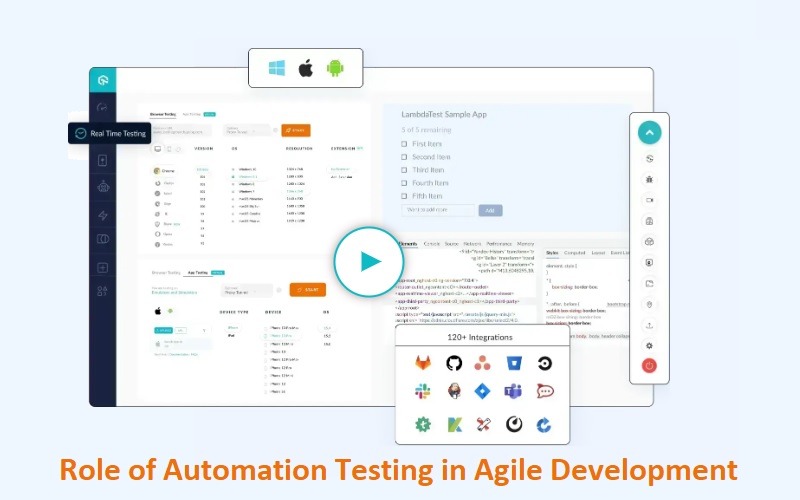As automation testing continues to become one of the most dominant factors in the modern application development and testing industry, developers need to integrate various practices to improve the efficiency of automated test cases. Agile development is one such practice that helps developers not only improve the accuracy of the automation test cases but also increase the efficiency of the overall testing environment. Agile development has a critical influence on modern testing processes like browser testing, performance analysis testing, quality assurance testing, and regression testing.
With this article, we are going to analyze the role of automation testing in the modern Agile development process. We will also go through some of the most important tips that can help automation testers and developers ensure success in this process.
What is Agile Development
In short, Agile development is a modern methodology used in software development that emphasizes collaboration, flexibility, and iterative progress. Using this development process, the testers can diverge from traditional linear approaches by promoting adaptive planning, early delivery, evolutionary development, and continuous improvement. The agile development approach also has a critical role in improving the collaboration between all the teams associated with the app-developing company. Let us now go through some of the key principles related to agile development:
● Use of Iterative Approach
Using agile development, developers can break down their projects into smaller increments or iterations. This approach allows them to perform frequent reassessments and adaptations as per the requirements of the application.
● Implementation of Collaboration
Agile development emphasizes close collaboration among cross-functional teams. These teams can include the testers, developers, designers, and stakeholders in the company. The primary goal of this approach is to foster transparency and communication within the software-developing company.
● Adaptability to Change
The primary concept of agile development is very welcoming to changes even if they are implemented at the later stages of the development process. It can respond to changes as per the customer needs or the market conditions. Therefore agile development is highly suitable for modern applications that tend to evolve continuously with the changing times.
● Scope of Continuous Delivery
The primary focus of agile development is to deliver a working product incrementally and regularly. This approach also allows quicker feedback and validation of the application infrastructure. Using this approach, the developers can deliver high-quality applications in a short period.
● Customer-Centric Approach
The primary goal of agile development is to adopt a customer-centric application development and testing process. Therefore, it prioritizes customer satisfaction by delivering software that meets their needs and expectations. To achieve these goals, it implements frequent iterations and feedback loops.
● Self-Organising Teams
The concept of agile development encourages the teams to be self-organizing and allows them to make decisions and adapt to changes. It also removes the heavy reliance on top-down management for receiving the clearances related to application development and testing standards.
Under agile development methodologies, there are various frameworks like Scrum, Kanban, Extreme Programming(XP), and many others. Each of these frameworks has its own set of practices, ceremonies, and rules. But all of them have the same core principles of adaptability, agility, and customer-centric focus.
We can easily say that the primary goal of agile is to improve the flexibility, speed, and responsiveness of the application development process. So, it helps to lead to higher quality software that better meets the customer needs in this ever-evolving landscape of technology.
Reasons to Implement Agile Development
In the modern software development industry, several compelling reasons drive the adoption of agile development with automation testing:
● Faster Time to Market Rate
The iterative approach of agile development helps the developers to quickly deliver the functional increments of the software. Thus, it enables businesses to respond faster to all the market demands and the changing requirements of the industry.
● Adaptability to Change
Since agile methodologies embrace changes in requirements, it allows the teams to pivot and adjust more efficiently to evolving customer needs or market conditions. Moreover, agile development allows the developers to implement these changes at any stage of the app development process.
● Improved Application Quality
By using agile development, the application developing companies can detect the bugs at the earliest stages of the development life cycle before it can turn into a serious concern. So, it has a crucial role in improving the quality of the application and ensuring that the developing companies can roll out a stable app to the customers.
● Implementation of Customer Satisfaction
Agile has a high priority towards customer collaboration and responsiveness. It also ensures that the delivered products align closely with customer expectations and needs. Using agile methodologies, app developers can constantly customize the application to ensure that they integrate all the recent market practices.
● Enhancing the Transparency and Communication
Agile promotes close collaboration among all the cross-functional teams present in app-developing companies. So, it helps to foster transparent alignments and communications on all the project progress and goals.
● Efficient Resource Utilization
Agile breaks down the work into smaller iterations and helps in optimizing the resource allocation. This process also has a crucial role in reducing wastage by focusing on high-priority features at the initial stages of the development and testing process.
● Risk Mitigation
The incremental approach of agile mitigates project risks by allowing teams to address issues early in the development process. So, it also helps to reduce the impact of potential setbacks that might be present in the source code of the application.
So, by adopting agile development practices, the developers can lead a more efficient, adaptable, and customer-centric software development process. This process not only helps to benefit the development teams but also the end users who would be accessing and using the product.
Tips for Ensuring Success of Automation Testing in Agile Development
Based on the standards and requirements of the modern software development industry, we have created a list of some of the most efficient tips that can help developers ensure the success of automation testing while implemented in agile development:
1. Early Involvement
The most important component for the success of automation testing with agile development is adopting these practices during the early stages of the application development and testing process. So, it is important to start automation testing as early as possible in the development cycle. This practice allows the implementation of a faster feedback loop catching issues sooner and reducing the rework required after the debugging process. It also prevents the possibility of a complete crash in the application infrastructure after it has been rolled out to the end users.
2. Selecting the Right Tools and Platforms
Modern tools and platforms have an important role in ensuring the stability and accuracy of the automation test cases. So, the developers need to choose the correct tools that align with the project requirements and are compatible with agile methodologies. For instance, Selenium is suitable when application developers are working on web applications. Some of the most important tools that are commonly used for different types of testing include Selenium, Appium, and JUnit.
Modern cloud platforms also help app developers improve the efficiency and accuracy of automation test cases with the integration of real device testing. Using these platforms, the developers can access thousands of real devices through remote servers. It also allows the execution of automation test scripts from all the popular frameworks like Selenium. Moreover, AI-powered test orchestration and execution platforms like LambdaTest have additional features like artificial intelligence-integrated automation testing, native bug tracker, and comprehensive test analysis reports.
3. Identifying the Test Cases for Automation
Identifying the test cases for the execution of automation testing is crucial to utilize the full potential of this process. Some of the most worthy candidates are the repetitive testing instances that need to be performed after every code change. The best examples in this category include regression testing, unit testing, and data analysis testing. These tests are usually repetitive, and time-consuming but critical for the application’s functioning.
4. Implementation of Continuous Integration and Continuous Deployment
The developers can integrate automated tests into the CI/CD pipelines to run the test cases efficiently. This is because it automatically executes the test instances whenever new code is committed into the testing environment. Using this process, the developers can also ensure that any changes made in the application source code do not break the functioning of the existing elements of the app. This process is also useful when the developers are working on the user interface elements present in modern cross-platform apps.
5. Maintaining the Test Data
The test data is one of the most crucial components of the modern automation test cases. Moreover, it is a common practice to reuse a huge section of the existing test data in future app development projects. So app developing companies must take efficient measures to maintain the test data and ensure that it remains relevant over a longer period. It is also crucial to adopt data-driven testing approaches for handling various testing scenarios efficiently.
6. Integration of Parallel Testing
Parallel testing is a modern testing process that allows application developers to initiate and execute multiple testing instances on different devices and configurations at the same time. Considering that modern applications consist of thousands of elements that require thorough testing, parallel testing can be a very useful integration. So, the developers can utilize this testing process to significantly reduce the testing time and expedite the feedback process. It also helps to improve the efficiency of the automation testing process when integrated with agile methodologies.
By integrating automation testing seamlessly into agile development practices and following the above tips, the teams can achieve faster delivery and improved quality of the application. This process also helps to increase the overall confidence in the software being developed by the company. However, the developers and testers must remember that certain tips might vary depending on the exact requirements of the application development project and the practices of the app company. So, we suggest the developers must have a clear conception of the target audience and the intentions for the application
The Bottom Line
Based on this article, we can justify that integrating automation testing with agile development is one of the most important parameters that modern developers and testers must focus on. It is also important for developers to constantly update themselves with revolutionary trends and innovations in the segment of automation testing. In this regard, the app-developing companies can also conduct seminars and workshops to spread the required knowledge. Surveying the target audience will provide crucial information regarding their needs and app usage practices. Based on this data, the developers can customize their application infrastructure to serve a wider section of users


